




- Sayyid Zulfikar Ali Khan, Nawab of Rampur (1933-1992)
- Sayyid Muhammad Kazim Ali Khan, Nawab of Rampur (born 1960)
- (1). Nawabzada Sayyid Ali Muhammad Khan (born 1989)
- (2). Nawabzada Sayyid Haider Ali Khan (born 1990)
- (3). Nawabzada Sayyid Yusuf Ali Khan
- Sayyid Muhammad Kazim Ali Khan, Nawab of Rampur (born 1960)
- Nawabzada Sayyid Abid Ali Khan (1943-1968)
- (4). Sahibzada Sayyid Raza Andrew Ali Khan (born 196-)
- (5). Sahibzada Sayyid Nadim Ali Khan (born 196-)
- Nawabzada Sayyid Abdul Karim Khan (1911-1996)
- (6). Sayyid Hassan Ali Khan (born 1945)
- (7). Sayyid Mohsin Ali Khan (born 1947)
- Sahibzada Shabir Ali Khan
- Sahibzada Muhammad Sajid Ali Khan (1904-1955)
- (8). Sahibzada Hamid Ali Khan (born 1929)
- (9). Sahibzada Shahid Ali Khan
- (10). Sahibzada - Ali Khan
- (9). Sahibzada Shahid Ali Khan
- (11). Sahibzada Kazim Ali Khan (born 1935)
- (12). Sahibzada Yusuf Ali Khan (born 1942)
- (13). Sahibzada Ali Muhammad Khan (born 1978)
- (14). Sahibzada Raza Ali Khan (born 1950)
- (15). Sahibzada Saleem Ali Khan (born 1952)
- (16). Sahibzada Sunny Ali Khan (born 1978)
- (17). Sahibzada Safee Ali Khan (born 2006)
- (18). Sahibzada Sami Ali Khan (born 1985) [ citation needed ]
- (16). Sahibzada Sunny Ali Khan (born 1978)
- (8). Sahibzada Hamid Ali Khan (born 1929)
- Sahibzada Muhammad Sajid Ali Khan (1904-1955)
Related Research Articles
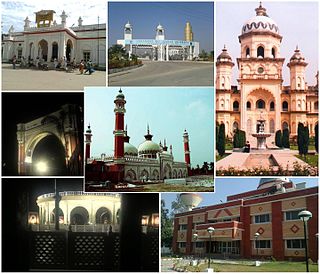
Rampur is a city, and the municipality headquarter of Rampur District in the Indian state of Uttar Pradesh. It was formerly known for its various industries, like sugar refining and cotton milling. Its library has more than 12,000 rare manuscripts and a fine collection of Mughal miniature paintings.
Begum Noor Bano served as a Member of Parliament in the 11th Lok Sabha and 13th Lok Sabha, lower house of parliament of India. She was elected from Rampur on the ticket of Indian National Congress party.

The Rampur Raza Library located in Rampur, Uttar Pradesh, India is a repository of Indo-Islamic cultural heritage and a treasure-house of knowledge established in the last decades of the 18th century. It was built up by successive Nawabs of Rampur and is now managed by the Government of India on the name of Raza Ali Khan of Rampur.
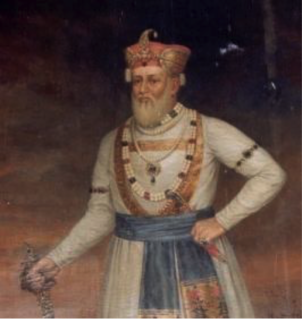
Nawab Sayyid Faizullah Ali Khan was the first Nawab of Rampur. The princely state of Rampur was set up in year 1774, after the First Rohilla War, by the dismemberment of the Rohilla Kingdom of Rohilkhand. Faizullah Khan, the only surviving heir of Ali Mohammed Khan and opponent of the forces of Awadh and the British East India Company in the war, was installed as ruler of what was the newly created Rampur State. It bordered the Maratha Empire to the south, making it a strategic point. Under tutelage of the East India Company, Faizullah Khan ruled peacefully for 20 years. The capital Rampur was founded, and the Raza Library collection gathered.

Rampur State was a 15 gun-salute princely state of British India. It came into existence on 7 October 1774 as a result of a treaty with Oudh. Following independence in 1947, Rampur State and other princely states of the area, such as Benares and Tehri Garhwal were merged into the United Provinces. Rampur state had its capital in Rampur city and its total area was 945 sq miles.
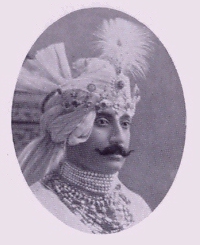
Sayyid Sir Wasif Ali Mirza Khan Bahadur was the Nawab of Murshidabad during 1906–1959. Sir Wasif Ali Mirza was educated at Sherborne School, Rugby School and later at Trinity College. He succeeded his father Hassan Ali Mirza Khan Bahadur at his death on 25 December 1906. On 11 December 1931, Wasif Ali was forced to surrender the administration of his estates to the Government of India after incurring a debt of ₹19 lakhs. On 15 August 1947, the Radcliffe Award allotted the district of Murshidabad to Pakistan and the Flag of Pakistan was hoisted at the Hazarduari Palace but within two days the two dominions exchanged Khulna, which is now in Bangladesh, and then the Flag of India was hoisted at the grand palace on 17 August 1947. The Government of India also resumed him all his estates in 1953. Wasif Ali was also the founder and president of the Hindu-Muslim Unity Association in the year 1937, named Anjuman-e-Musalman-e-Bangla, which promoted Hindu-Muslim unity. The Nawab also built the Wasif Manzil.

Nawab Muhammad Yusef Ali Khan Bahadur, KSI, was a Nawab of the princely state of Rampur from 1855 to 1865. During the First War of Independence, he rendered many useful services to the Government of India by keeping the British supply and communication lines to Naini Tal open, rescuing fugitives and securing the town of Moradabad. For his service, he was granted extensive lands in Bareilly by the Viceroy of India, Lord Canning, was knighted in 1861 and given a 13-gun salute along with the style of His Highness. Finally, he was made a member of the Viceroy's Council. Despite this multitude of honours, Sir Yusef continued to preserve the Mughal artistic tradition by inviting musicians, scholars and artists of Bahadur Shah Zafar II's court to resettle at Rampur, including the great poet Ghalib. Dying at 49 in 1865, he was succeeded by his son, Sir Kalb Ali Khan Bahadur.
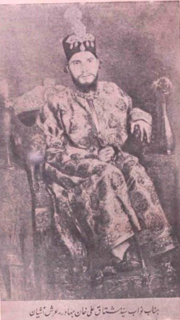
Nawab Muhammad Mushtaq Ali Khan Bahadur, was a Nawab of the princely state of Rampur from 1887 to 1889, succeeding his father Sir Nawab Kalb Ali Khan Bahadur. Owing to continued ill-health, he was unable to properly rule and govern the state and so left its affairs in the hand of an administrative council. However, he was successful in continuing the beneficiaries of his predecessors, particularly in the areas of agriculture and irrigation. He died at the age of 32 in 1889 and was succeeded by his son, Sir Hamid Ali Khan Bahadur.

Nawab Sayyid Hamid Ali Khan Bahadur was Nawab of the princely state of Rampur from 1889 to 1930.

Sir Raza Ali Khan Bahadur GCIE, KCSI was a nawab of the princely state of Rampur from 1930 to 1966. A tolerant and progressive ruler, Sir Raza expanded the number of Hindus in his government Including his Prime Minister Lt.Col. Horilal Varma Bar At Law and, expanded the irrigation system, completed electrification projects and continued building schools, roads and sewage systems. Also patriotic, the Nawab sent his soldiers to fight in the Middle Eastern theatres of the Second World War. Acceding to the Union of India on 15 August 1947, Rampur was formally merged with it in 1949 and with the new state of Uttar Pradesh in 1950. Afterwards, Sir Raza devoted himself to charitable projects and to his post as head of the Freemasons in India as the first Grand Master of the Grand Lodge of India.
Nawab Sayyid Murtaza Ali Khan Bahadur, MBE was the titular Nawab of Rampur from 1966 to his death in 1982, succeeding his father, Nawab Raza Ali Khan Bahadur. Murtaza was succeeded by his younger brother Zulfikar Ali Khan Bahadur.
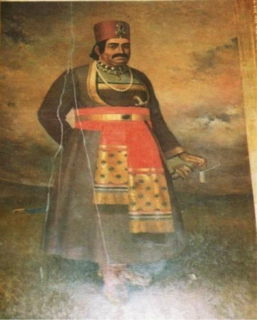
Nawab Ahmad Ali Khan Bahadur was Nawab of Rampur from 1794 to 1840, succeeding his brother Ghulam Muhammad Khan Bahadur. The only son of Muhammad Ali Khan Bahadur, Ahmad Ali was made Nawab following the deposition of his cousin Ghulam Muhammad by the British East India Company and the Nawab of Awadh. Ahmad Ali ruled for 46 years, although he reigned from 1794–1811 under a regency. He transformed the cultural fabric of Rampur and started a tradition of cultural involvement that has been maintained by his successors to the present day. In 1801, Rampur became a vassal of the HEIC following the cession of Rohilkand by the Nawab of Awadh. Ahmad Ali died on 5 July 1840, aged 52. As his only son had died young, he was succeeded as Nawab by his cousin, Muhammad Said Khan Bahadur.

Nawab Muhammad Said Khan Bahadur was Nawab of Rampur from 1840 to 1855, succeeding his cousin Ahmad Ali Khan Bahadur. The son of Ghulam Muhammad Khan Bahadur, Muhammad Said spent his early years in the service of the East India Company, eventually rising to the rank of Deputy Collector for Dudain. Although his father had been a tyrant during his brief reign, Muhammad Said by contrast proved to be a benevolent and progressive ruler, building irrigation works and establishing courts of law and an advanced legal code. Muhammad Said died on 1 April 1855 in his 69th year and was buried at Rampur. He was succeeded by his eldest son, Yusef Ali Khan Bahadur.
Major Nawab Sayyid Zulfikar Ali Khan Bahadur was an Indian politician and an Indian army officer who ruled as Titular Nawab of Rampur from 1982 to 1992, succeeding his elder brother Murtaza Ali Khan Bahadur.
Nawab Sayyid Muhammad Sharif Ali Khan Bahadur is an Indian politician and was a member of the 16th Legislative Assembly of Uttar Pradesh of India. Muhammad Kazim Ali served as an MLA in the Swar Tanda Uttar Pradesh state assembly; in 2003 he was briefly the state minister for Minority Welfare and Hajj Affairs. Since 2003, he has been the Chairman of the Uttar Pradesh Tourism Development Corporation.
The line of succession to the former throne of Hyderabad was by male primogeniture, regardless of legitimacy. As per Mughal Turkic custom, however, the ruling Nizam could exercise the option of designating any eligible male member of the dynasty as his successor.
The line of succession to the former throne of Bhopal, among the pre-eminent Indian principalities, was, uniquely amongst the Indian princely houses, by male-preference primogeniture in the direct family line. This principle of succession was formally established by the last Nawab of Bhopal, Hamidullah Khan, upon his confirmation as ruler of Bhopal in 1926. Since his death in 1960, the identity of the present rightful claimant to the former throne remains a matter of contention, though the claim of the descendants of his second daughter Sajida Sultan has been recognised by the Indian government and courts. As the Indian government has discontinued the official recognition of princely families since 1971, however, this question has primarily been examined since then with respect to property inheritance rights.

The Rohilla Dynasty is an Indian dynasty of Arab origin that ruled Rohilkhand, and later the Princely State of Rampur. Descending from the Barha Dynasty,best known for being de facto rulers over much of South Asia at the start of the 18th Century, the dynasty ruled Kumaon and Imperial viceroyalty of Punjab, an area comparable in size to Germany, Denmark and Austria. With their borders reaching the edge of Delhi the dynasty had almost complete control over the affairs of the Indian Emperors.